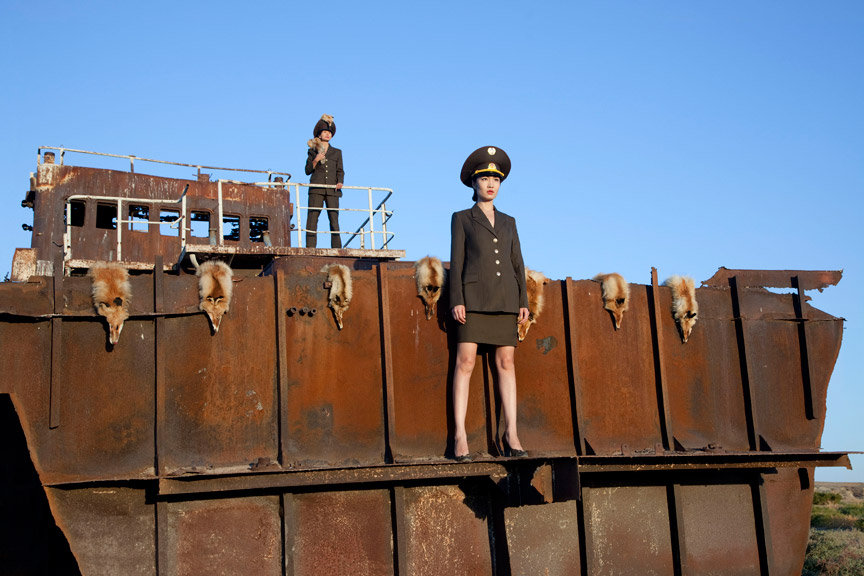Shows
“Between Heaven and Earth: Contemporary Art from the Centre of Asia” at Calvert 22


“Between Heaven and Earth: Contemporary Art from the Centre of Asia” was an ambitious yet effective exhibition, as befits the strong record of Calvert 22, the London-based foundation set up to promote contemporary art from Russia and Eastern Europe. The show’s curator, David Elliott, presented work by 23 collectives and artists from the former Soviet Republics of Kazakhstan, Kyrgyzstan, Tajikistan and Uzbekistan, as well as Afghanistan and Mongolia.
Despite the tantalizing opportunity to explore the impact of the Soviet withdrawal on art and society since the 1990s—and the new roles being forged by older artists trained in the Moscow Schools, as well as by their younger compatriots—the exhibition, perhaps wisely, steered clear of such a wide remit. The diversities of pasts and presents in the six countries—physical, political, religious, economic and artistic—would have made this a massive undertaking. Elliott instead highlighted the quality of the work being created across the entirety of Central Asia, an area he feels is too often overlooked or caricatured in the Western media. He also suggested a new collective assertiveness among its artists, epitomized by their ability to move beyond the tragedies of the past and “meld the ether of idealism . . . with a sensual practicality that is savage, earthy and ironical.”
Almagul Menlibayeva’s film Transoxiana Dreams (2011) captures this newfound artistic confidence. The desertification of the Aral Sea due to Soviet irrigation is seen through the eyes of a child, with documentary-style footage of life in its bleak landscapes juxtaposed with animistic sequences of women as mythical beings, posing against rusting remnants of Soviet occupation. The hypnotic result weaves commentary on Soviet exploitation around Menlibayeva’s quest for ancestral identity through her surreal language, self-described as “Romantic Punk Shamanism.”
Many of the works selected were overtly political. The Defragmentation of History (2011) by Galim Madanov and Zauresh Terekbay was one of many pieces suggestive of the traumatic nature of encounters with the great powers, past and present. The work is a series of 40 delicate oil-and-gold paintings with raised letters spelling out authors and titles of books on “The Great Game”—the 19th-century Anglo-Russian struggle for regional dominance that has been appropriated by journalists to describe current scrambles for political and economic influence in Central Asia. Erbossyn Meldibekov’s heavily battered enamel pots in The Peak of Communism, Autumn, Winter (2009) evoke similar concerns with a particularly incisive humor. Each of these metal re-creations of the highest peak in the Pamir range refers to the mountain at a different moment in its appropriation by competing political powers.
Such works are forceful, layered with irony and even anger, but their preponderance in the exhibition did risk undermining some of its purposes. “Between Heaven and Earth” aspired to move beyond characterizations of Central Asia as a closed wasteland, haunted by history, political upheaval, and environmental and industrial degradation. To show so many works in which these same themes are so prominent suggests that, in many respects, they remain fundamental to the area’s artistic practice. The exhibition thus ran the risk of reinforcing, rather than refining or bursting beyond, existing generalizations concerning the region. It was therefore reassuring to turn to works that tackled changes in society on a smaller scale, touching on the prosaic or even banal. In each of the 42 photographs of Yelena Vorobyeva and Viktor Vorobyev’s poetic series “Kazakhstan, Blue Period” (2002–05), splashes of koh, the popular green-blue color, can be found on, say, a watermelon stand or a public building. Reflecting intangible yearnings—national aspirations, religious sentiment or the loss of community—the photographs balance melancholy with optimism.
“Between Heaven and Earth” was a demanding experience for visitors. Given the range and density of references, influences and nationalities, the provision of captions for each work should have been considered. However, the blend and quality of works was uniformly impressive, making a strong case for further surveys investigating the paths taken toward recasting artistic identities in the post-Soviet era.







